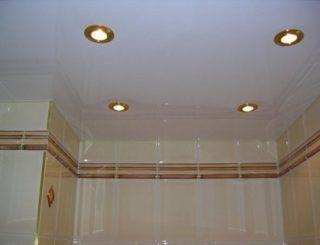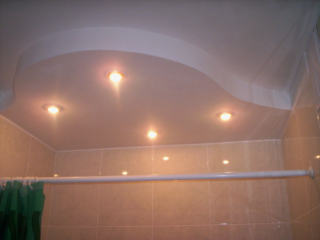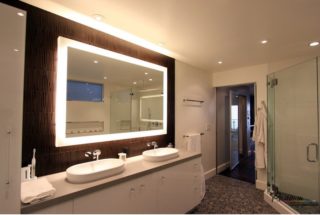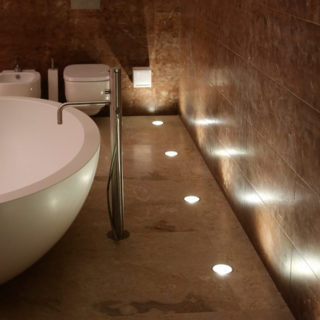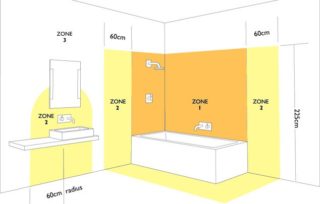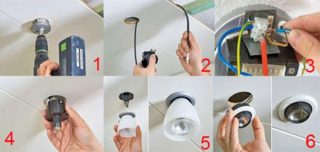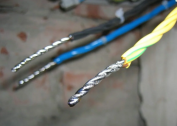Lighting in the bathroom performs the main function - providing the room with the necessary light - and also plays the role of decoration. An integrated approach to this issue requires thoroughness in the design of the room and in the selection of fixtures.
Number of fixtures
The number of bulbs and their power in the bathroom directly depends on the area of the room.
- Up to 5 sq.m - from 60 to 150 watts.
- 5 to 10 sq.m - power varies between 80 and 250 watts.
- 10 to 15 sq.m - lighting at the level of 100-400 W.
- 15 to 20 square meters - the minimum degree is 200 watts, the maximum is 500 watts.
- 20 to 30 square meters - the brightness of the light is set on the verge of 240-700 watts.
The minimum value corresponds to soft light, and the maximum value is very bright. However, general lighting is not enough, you need to take care of the functional. We are talking about areas near the mirror, washbasin and bath.
It is also recommended to consider the option with a decorative light source in the form of a garland or atmospheric lamp.
Lighting Design Techniques
Interior designers using several types of light sources and diverse placement can fundamentally change the style of a room:
- visually increase or decrease the room;
- create the necessary atmosphere (romantic or purely practical).
To achieve the expected effect of lighting in the bathroom, you should be guided by a number of simple recommendations.
Ceiling Light Organization
Any bathroom involves an overhead light. This role can be performed by:
- decorative designer chandelier (for artsy interior);
- Spotlights.
In the first case, it is enough to place the lamp in the center of the ceiling, in the second you need to work on the placement. You can position the bulbs in the central part or above the functional areas.
Care must be taken to ensure that no shaded areas remain in the room.
For greater brightness of light, reflective surfaces or devices are used. For example, an aluminum suspension with small lamps directing light downward. This arrangement creates a fabulous atmosphere.
Emphasis on the main interior element
The light in the bathroom focuses on the main plumbing - the bathroom. It stands out in the following ways:
- Installation of equipment on a hill. The pedestal below is striking in the spotlight around the perimeter.
- The bathing bowl is equipped with a minimalist ceiling chandelier or an ordinary shade.
- LED lights in the bathroom. Located at the edges of the bath, light lines create the illusion of flowing water.
Considering a pretty attractive feature with autonomous light hidden in the bath itself.
If there is a shower room in the room, emphasis should be placed on the watering can. For a greater effect, the bulb is mounted directly in the watering device, after which the water jet acquires a new color.
Mirror Lighting
Even in a small Khrushchev in the restroom there is a mirror, which is the basis of the working area. It is installed in most cases above the washbasin or next to the bedside table with cosmetics. Before choosing light bulbs for a mirror, it is important to familiarize yourself with three rules:
- refuse dazzling light;
- minimize the formation of shadows on the face;
- to ensure maximum compliance with the color temperature of natural light sources.
Natural light equals light on a sunny cloudless day.
There are two options: stand-alone or integrated lighting. In the first case, two lamps are attached on the sides and top. In the second - the mirror is equipped with hidden lighting.
Furniture selection
In the bathroom, detergents and hygiene products are usually stored. In order not to leave objects in sight, they are placed in small wall or floor tables.
The accessories do not require bright highlighting with light. However, for ease of use, you can equip them with functional lighting, with which you can distinguish all things and get what you need.
Lower level
Light underlining of the room parameter performs two functions: decorative and emergency. To highlight the floor area or low furniture levels, sealed low-power bulbs are used - the performance does not exceed five watts, and the diameter is five centimeters.
A more original approach to backlighting will be provided by an LED strip, which is resistant to moisture. If this way to fence the entire perimeter of the bathroom, there is a sensation of soaring and weightlessness.
Individuality and expression through lighting
With the help of well-chosen light in harmony with the interior, you can embody the underwater world or the night sky in one room. You can also follow all the rules of the loft, leaving the screwed-in light bulbs on the same wires, so that at any time to dim the bright light.
For the right lighting, different types of lamps are selected, differing in brightness and responsible for certain zones.
Characteristics of various lamps
Making a room with a toilet, you need to choose the type of light bulbs. The most popular include:
- Incandescent lamps. An artificial light source is able to emit light rays due to the heating of the glow body by electric current. It is characterized by comparative low cost and resistance to voltage drops. However, significant shortcomings are observed: a short operational period, fragility, and high fire hazard. It is better to use them near the makeup table.
- Halogen lamps. The principle of operation is the same as that of Ilyich's bulbs, only there is a distinctive feature - there is a buffer gas. The good thing is that in some cases there is a mode for adjusting the angle of illumination, high resistance to moisture. Suitable for bathtubs with a classic interior design.
- Fluorescent lamps. Ultraviolet radiation is generated in mercury vapor through an electric discharge, passing into visible light with the help of phosphors. Best used for lighting large areas.
- LEDs Lamps are equipped with semiconductor devices that emit white or a different color. Unlike other models, the described lamps are characterized by a high level of fire safety and provide the maximum natural effect.
The use of any type of bulb is limited to functional areas and safety rules. All standards are built on the basis of a protective index.
Security Index and Bathroom Areas
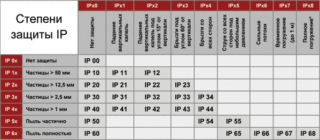 Security index - an indicator that reveals the level of protection against external factors. Contains a three-digit code:
Security index - an indicator that reveals the level of protection against external factors. Contains a three-digit code:
- The first digit is responsible for protection against dust and dirt. It is estimated in the range of 0-6 points.
- The second determines the moisture resistance. The score is set within 0-8 points.
- The third shows impact resistance. The ability to resist mechanical stress is estimated at 0-10 points.
The higher the ratio, the higher the quality of the product. Understanding the designations helps the buyer to correctly navigate the assortment and choose the right product.
Humidity zones
There are several humidity zones:
- The highest degree. Here is the bowl of the bath (the space above and below it) or shower, water flows, steam and condensate form. Light bulbs should have a maximum power of 12 watts and with a maximum protection index.
- Elevated level. Water enters the fixtures in the form of droplets or steam. It refers to the washbasin and its adjoining surfaces. Protection factor should be at least 450 IP.
- Moderate humidity. Half a meter from the first zone. IP of suitable luminaires is 242 or more.
- The normal level is the remaining space.
For a space with a minimum level of moisture, bulbs with a minimum coefficient of IP 011 are suitable.
Methods of fixture mounting
There are three main methods for attaching ceiling lights:
- on a ceiling hook - for large-sized devices;
- on the mounting plate;
- on the cross bar.
Planks provide installation of the chandelier close to the ceiling, but due to complicated installation work. Wall-mounted models are simpler - light sources are mounted on ordinary nails or dowels.
Installation of electrical wiring in the bathroom
Installation of fixtures takes place in several stages. The first important step is planning and design. The quality of lighting depends on it. At the starting stage, the required lighting power is calculated.
For the bathroom and bathrooms, 200 lumens per square are needed. The specified requirement corresponds to:
- incandescent lamps 25 W - 200 Lm, 100 W - 1350 Lm;
- halogen bulbs - 42 W - 625 Lm, 70 W - 1170 Lm;
- luminescent lamps - 40 W - 2000 Lm;
- LED - 40 W - 6000 Lm.
For the correct calculation of power, you need to take into account: the size of the room, color characteristics and level of reflection, height and furniture.
The next step is to select the cross section and type of wires. A correctly made cross-section diagram is considered the key to high-quality and safe wiring. It is important to think about places for installing future electrical appliances, sockets and the switches themselves. It should be guided by common tips:
- approximate number of outlets - no more than three pieces;
- for washing machines, take a separate outlet;
- mount the switch outside the bathroom, for example, in the corridor;
- wiring lines are vertically and horizontally.
The final stage is installation work. Depending on the installation location, the necessary equipment and workflow are changing.
How to mount the lights
There are two main points on which the feature of installation depends: the type of lighting device and the installation location.
- To the main ceiling. To conduct central lighting, spherical shades and lamp plates are used. If the ceiling surface is made of concrete, hardware or dowels are used for installation, from wood - self-tapping screws.
- Plasterboard suspended ceiling. In most cases, spotlights are installed here. Pre-planned wiring. The installation process itself consists of a series of actions: mandatory disconnection of voltage, connecting the lamp to the cable terminals, introducing the lamp into the housing and screwing in the bulb.
The last option is a stretch ceiling. The mounting process is very complicated here, since the stretched web is very easily damaged. To avoid unpleasant moments, you should remember:
- careful design of the layout of the fixtures before installation;
- obligatory cable insulation;
- the formation of embedded platforms or hooks for all fixtures.
For stretch ceilings, it is recommended to use fluorescent or LED lamps. Devices do not heat up and do not provoke damage to the canvas.
Safety regulations
 Lighting in the bathroom requires special attention due to high humidity and direct contact with residents.The following rules will help to avoid negative consequences:
Lighting in the bathroom requires special attention due to high humidity and direct contact with residents.The following rules will help to avoid negative consequences:
- entrust the development of lighting schemes to professionals;
- use only moisture-proof lamps;
- protect metal parts of devices from rust and corrosion;
- Do not place sconces directly above the bath;
- the use of halogen and incandescent lamps in the first three functional areas is not permitted;
- no open wiring, extension cords or tees.
The lighting in the bathroom should be approached comprehensively, taking into account all the factors affecting the choice of lighting - from safety standards to a harmonious combination with interior solutions. Thanks to the right light, you can make the room comfortable and cozy.
